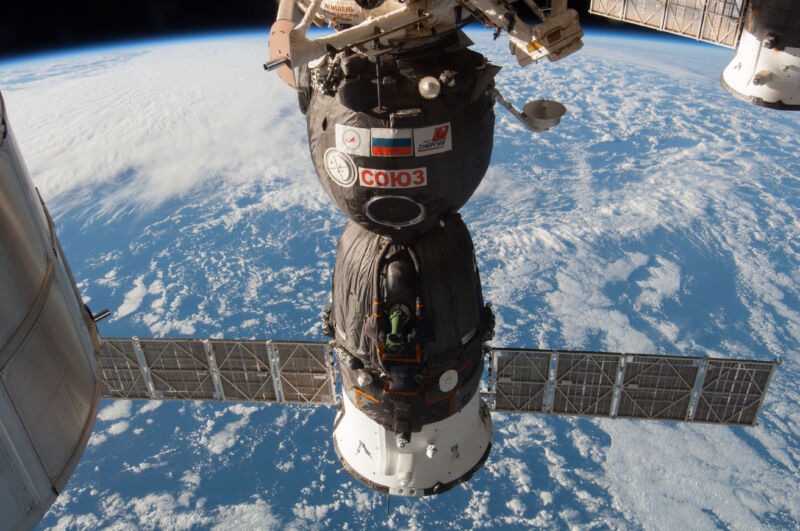
Today, NASA held a press briefing to describe the situation on the International Space Station (ISS) in the wake of a major coolant leak from a Soyuz spacecraft docked at the station. At this time, neither NASA nor Roscosmos have a clear picture of the possibilities of using the damaged spacecraft. If it is unusable in its current state, it will take until February to get a replacement for the ISS.
Soyuz spacecraft are one of two vehicles used to get people to and from the ISS, serving as “rescue boats” in case personnel are needed to quickly evacuate the station. So while the leak doesn’t endanger the ISS or its crew, it does reduce the margin of error and could potentially disrupt future crew rotations.
As Roscosmos pointed out earlier this week, the impressive-looking plume of material emerged from a millimeter-sized hole in a coolant radiator. Although the coolant system has redundant pumps that can handle failures, the leak resulted in the loss of all coolant, so there is nothing to pump at this time.
Sergei Krikalev, the executive director of Roscosmos’ Human Space Flight Programs, said ISS partners have already conducted an analysis comparing the hole’s orientation to the likely direction a micrometeorite would have come from. The two don’t match, so there’s no indication of how the damage occurred. The coolant does not pose a threat to the exterior of the ISS.
At the time of the damage, the next Soyuz launch to the ISS was scheduled for a crew rotation in mid-March. Krikalev said that could be pushed forward a few weeks to the end of February, which would bring an undamaged lifeboat to the station. Whether that will carry a replacement crew or not will depend on whether the damaged capsule is considered safe enough to return the current crew to Earth. (Soyuz can automatically dock at the station so it can be sent to the ISS unmanned.)
At this point, however, we are still not sure if the damaged Soyuz can safely return the crew to Earth if there is no system to cool the internal compartment. “As soon as we start turning on equipment and once the crew is in the crew compartment, temperatures start to rise,” Krikalev said. “We don’t know exactly how high it will be [get]and our specialists in Russia will work with specialists in Houston to estimate how fast the temperature is rising and what maximum temperature can be reached during different ways of reentry.”
Those different modes include an option that minimizes the amount of time Soyuz spends in space before returning. There’s also the option of what Krikalev called “analog re-input,” which is essentially manual control of the process, allowing some of the internal electronics to be turned off. Should any of these reentry options prove viable, the Soyuz at the ISS can fulfill its role as a lifeboat despite the damage. Whether “viable in an emergency” is desirable for a crew rotation is a separate issue.
“If nominal access is dangerous — or not safe enough, I would say,” Krikalev said, “we’ll send a vehicle to have a good spacecraft for the crew.” That vehicle would be empty, meaning an extended stay on station for the existing crew, and the ISS would not have a lifeboat until it arrived. NASA’s Joel Montalbano indicated that, in this case, the damaged Soyuz would be sent through empty space to allow Roscosmos to get data on its behavior.
In the meantime, Montalbano said, things are returning to normal on the ISS, with a spacewalk underway to install solar panel upgrades. He said the next rotation of US personnel is still scheduled for a Jan. 9 departure on a Dragon spacecraft.

